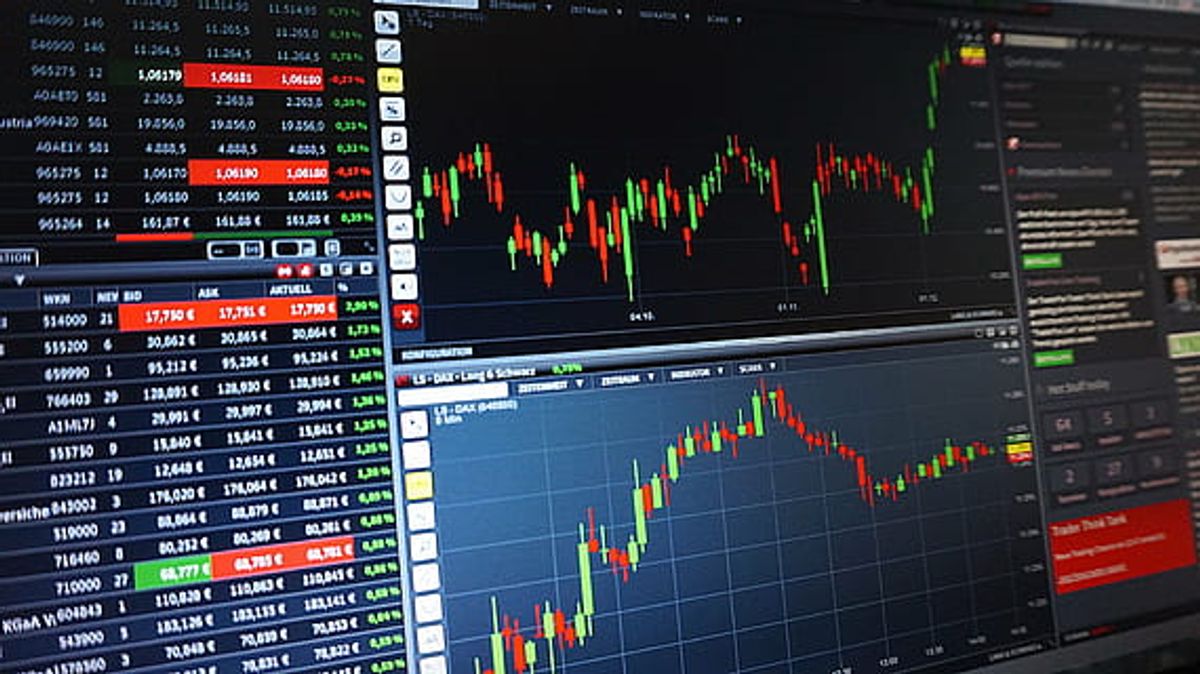The fluctuating stock price of Facebook, now known as Meta Platforms Inc., has been a point of intrigue and analysis for investors around the globe. Understanding the reasons behind the surges and dips in Facebook’s stock price is crucial for making informed investment decisions. This article delves into the various factors that affect the stock’s performance, from big tech trends and executive decisions to financial performance drivers and investor behavior. Additionally, it offers a comparative analysis with other tech giants and provides strategic insights for investors considering Facebook stock.
Key Takeaways
- Facebook stock price fluctuations are influenced by broader big tech trends, executive decisions, and market sentiments.
- Key drivers of Facebook’s financial performance include advertising revenue, user growth, and investments in emerging technologies like the metaverse.
- Investor behavior, including the actions of institutional and retail investors, plays a significant role in the stock’s volatility.
- Comparative analysis with other tech giants reveals Facebook’s market position and helps in assessing insider trading activity as a confidence or caution indicator.
- Investors should consider market timing, diversification, and Facebook’s long-term prospects when deciding to buy or hold the stock.
The Dynamics of Facebook Stock Fluctuations


Influence of Big Tech Trends
The performance of Facebook’s stock is not only a reflection of the company’s individual success but also a barometer for the tech industry at large. Big Tech trends significantly sway the market’s confidence, influencing investor decisions across the sector. For instance, when major cryptocurrencies rallied after the collapse of a significant US bank, Meta, along with other tech giants, experienced a ripple effect in their stock prices.
- Meta and Alphabet benefited from increased advertising spend by technology start-ups.
- The ‘Magnificent Seven’ tech companies, including Facebook, often move in tandem, reflecting broader market sentiments.
The interconnectivity of Big Tech firms means that the surge or dip in one can lead to a domino effect, impacting the stock prices of others.
The table below highlights the recent performance of Facebook compared to other tech giants after key financial announcements:
| Company | Q4 Results Reaction | Interest Rate Context |
|---|---|---|
| Meta (Facebook) | Positive | Fed Funds Rate: 4.5%-4.75% |
| Apple | Mixed | Bank Rate: 4% |
| Amazon | Negative | – |
| Alphabet (Google) | Mixed | – |
Investors must consider these interdependencies when evaluating Facebook’s stock, as shifts in the tech landscape can have significant implications for the company’s financial health and stock valuation.
Impact of Executive Decisions on Share Prices
Executive decisions can have a profound impact on a company’s share price, often serving as a barometer for the company’s future prospects and the confidence of its leadership. Decisions such as earnings reports, stock buybacks, or executive share sales can send strong signals to the market.
For instance, when executives sell their shares, it might indicate a peak in stock price or a desire to diversify personal assets. However, such actions can also raise concerns among investors about the potential for a market correction. Finance analysts suggest that these moves are typically strategic, with executives waiting for opportune moments to capitalize on gains.
- Executive share sales
- Stock buybacks
- Earnings report announcements
- Strategic company decisions, like delisting
The value of shares is not solely dependent on these executive maneuvers but also on the underlying fundamentals of the business. The real implications for shareholders often lie in the reasons behind these decisions and how they align with the company’s long-term strategy.
Analyst Predictions and Market Sentiments
Analyst predictions and market sentiments play a pivotal role in shaping the trajectory of Facebook’s stock price. Market sentiment is often a reflection of broader economic indicators and specific events impacting the tech industry. For instance, bullish optimism can lead to a ‘Santa Claus Rally,’ where stock prices surge towards the year-end, influenced by positive forecasts and investor psychology.
The interplay between analyst outlooks and investor sentiment can create self-fulfilling prophecies, as optimistic predictions fuel buying sprees, while bearish reports can trigger sell-offs.
Market sentiments can swing from extreme optimism to caution within a short span, as seen in the fluctuation of sentiment indexes and reactions to earnings reports or economic forecasts. Here’s a snapshot of sentiment trends over recent months:
- June: Sentiment Index increases, signaling bullish markets.
- September: Market rallies on the realization the Fed is done.
- December: Rally into year-end on bullish optimism?
Understanding these patterns is crucial for investors looking to navigate the volatile landscape of tech stocks like Facebook.
Key Factors Driving Facebook’s Financial Performance


Advertising Revenue and User Growth
Facebook’s financial health is significantly influenced by its advertising revenue, which has shown robust growth, aligning with the broader trends in digital advertising. The platform’s ability to attract a vast user base is pivotal, as it directly impacts the volume of ad impressions available to marketers.
In the context of user growth, Facebook’s Monthly Active Users (MAUs) are a critical metric. As of December 31, 2023, MAUs reached 3.07 billion, marking a 3% increase year-over-year. This growth, although modest, is essential for sustaining ad revenue.
The interplay between user engagement and ad revenue is a cornerstone of Facebook’s business model, with each element fueling the other in a virtuous cycle.
The following table summarizes the recent trends in Facebook’s advertising metrics:
| Metric | Q4 2022 | Q4 2023 |
|---|---|---|
| MAUs | 2.98B | 3.07B |
| Ad Impressions | Increase | Increase |
| Price per Ad | Stable | Increase |
These figures underscore the importance of maintaining and growing the user base to support a thriving advertising ecosystem.
Investments in the Metaverse and New Technologies
Facebook’s pivot towards the metaverse and new technologies has been a significant factor influencing its stock price. Meta’s commitment to AI and the metaverse represents a long-term investment that has both intrigued and concerned investors. The company’s aggressive push into these areas, as highlighted by the stockpiling of nearly $9 billion worth of Nvidia chips, underscores the scale of its ambitions.
Despite the potential of these investments, the market response has been mixed. Some investors are optimistic, seeing Meta’s shift as a move towards efficiency and high-growth opportunities. Others remain skeptical, questioning the immediate returns on the hefty investments in the metaverse, which has yet to prove its profitability.
The recent surge in tech stocks, particularly those associated with AI, suggests a growing enthusiasm for the sector. However, Meta’s journey is not without its challenges, including regulatory pressures and concerns over online advertising demand.
The table below provides a snapshot of Meta’s recent financial performance, reflecting the impact of its strategic decisions:
| Quarter | Revenue | Net Income | R&D Expenses |
|---|---|---|---|
| Q1 2023 | $29B | $7.5B | $5B |
| Q2 2023 | $30B | $8B | $5.5B |
As the landscape of social media and technology continues to evolve, Meta’s investments in AI and the metaverse will likely remain a focal point for investors assessing the company’s future.
Regulatory Challenges and Data Privacy Concerns
The landscape of digital privacy and data management is a minefield for tech companies, with Facebook at the forefront. Regulatory bodies are intensifying scrutiny, imposing new rules that demand transparency and responsible data handling. This has led to a heightened focus on how social media platforms manage user information.
- The introduction of ‘Consumer Duty’ requirements by the FCA emphasizes the need for customer empowerment in financial decisions.
- Anti-trust and national security concerns are cited as significant barriers to mergers and acquisitions.
- Misleading social media advertisements have come under fire, with regulators demanding clarity and risk communication.
Regulatory pressures are not just about compliance; they’re reshaping how companies like Facebook operate and engage with users.
The FCA’s recent actions against ‘finfluencers’ and unclear social media promotions reflect a broader trend of tightening controls over digital content. These measures are not only about protecting consumers but also about maintaining the integrity of the financial system.
Investor Behavior and Market Reactions
Patterns of Buying and Selling Among Institutional Investors
Institutional investors play a pivotal role in the stock market, often setting trends that can lead to significant surges or dips in stock prices. Their buying and selling patterns are closely monitored as they can provide insights into the market’s direction. For instance, a shift towards global funds and funds of funds, as reported by Forbes Advisor, indicates a diversification strategy that may reflect a cautious stance towards market volatility.
The patterns of institutional investors reveal a strategic approach to navigating market uncertainties, with a preference for diversified and cautious fund choices during turbulent times.
The data also shows a keen interest in scrutinizing the track records of fund managers, as underperformance can lead to substantial shifts in investment strategies. This scrutiny has led to the identification of a significant number of underperforming funds, prompting investors to reconsider their allocations.
Here is a snapshot of recent trends in institutional investment behavior:
- Global funds: Top choice for diversification
- Funds of funds: Preferred for risk management
- Precious metal funds: Sought after for stability
- Cautious funds: Popular during market downturns
These trends underscore the importance of monitoring institutional investment patterns, as they can serve as a barometer for the overall health and sentiment of the stock market.
The Role of Retail Investors in Stock Volatility
The landscape of the stock market has seen a significant shift with the rise of retail investors. These individuals, often characterized by a higher risk tolerance, have become a notable force in market dynamics. Their collective actions can lead to substantial price movements, particularly in stocks popular within retail trading communities.
Retail investors have been empowered by new platforms that offer features like fractional shares and extended trading hours. This democratization of investing has allowed for greater participation, but also introduces new layers of volatility as these investors may react swiftly to market changes or social media trends.
- Increased accessibility: Fractional shares and 24-hour trading.
- Social media influence: Rapid dissemination of information.
- Market sentiment: Prone to swift changes based on retail investor behavior.
The interplay between retail investor activity and stock volatility is complex, with these market participants both responding to and driving price fluctuations.
Sentiment Analysis: Fear and Greed in the Market
Investor sentiment is a powerful force in the stock market, often driving prices beyond fundamental valuations. The Fear and Greed Index is a popular tool used to understand these emotional swings. When the index is high, greed is driving the market, suggesting that stocks may be overvalued. Conversely, a low index indicates fear, which can signal undervaluation.
It’s essential to recognize that these emotional tides can lead to irrational investment decisions. The key is to remain objective and not let fear or greed dictate your trading strategy.
Current sentiment readings suggest a market that is heavily influenced by greed, with the index nearing its upper limit. This could imply that caution is warranted, as historically such levels often precede a market correction. Here’s a snapshot of the current sentiment:
| Fear/Greed Index | Current Reading | Possible Maximum |
|---|---|---|
| Risk Assessment | 94.74 | 100 |
Understanding these metrics and monitoring shifts in sentiment can be crucial for investors looking to time their market moves effectively.
Comparative Analysis with Other Tech Giants


Facebook’s Stock Performance Versus the ‘Magnificent Seven’
When comparing Facebook’s stock performance to that of the ‘Magnificent Seven’, a group that includes some of the most influential tech giants, it’s clear that the landscape is highly competitive. Facebook, now known as Meta Platforms, has had its share of peaks and troughs alongside its counterparts such as Apple, Microsoft, and Nvidia.
The performance of these tech behemoths is often seen as a barometer for the sector, and any shifts can have wide-reaching implications. For instance, while Nvidia has experienced a notable slide, Meta has had moments of ‘breakaway’ performance, highlighting the volatility and dynamism within this elite group.
Despite the occasional divergences in performance, the Magnificent Seven collectively continue to exert a significant influence on global stock markets, often dictating investor sentiment and market trends.
The table below provides a snapshot of how Meta’s stock has fared in comparison to the other members of the Magnificent Seven over a recent period:
| Company | Stock Performance (%) | Market Capitalization (USD) |
|---|---|---|
| Meta Platforms | X.X | XXX billion |
| Apple | X.X | XXXX billion |
| Microsoft | X.X | XXXX billion |
| Alphabet | X.X | XXXX billion |
| Amazon | X.X | XXXX billion |
| Nvidia | X.X | XXX billion |
| Tesla | X.X | XXXX billion |
Note: The ‘X.X’ and ‘XXX billion’ figures are placeholders for actual performance and market cap data.
Market Capitalization and Valuation Metrics
When assessing Facebook’s position in the tech industry, market capitalization and valuation metrics are indispensable tools for investors. Facebook’s market cap, alongside other tech giants, reflects its substantial influence and potential for growth. These metrics not only represent the company’s current financial health but also provide insights into future performance expectations.
Valuation metrics, while indicative of the market’s view on a company, can also signal investor sentiment. For instance, a high price-to-earnings (P/E) ratio might suggest that investors are willing to pay a premium for expected growth or stability. Conversely, more conservative valuations may indicate skepticism or a focus on value.
The recent shifts in market capitalization among tech giants highlight the dynamic nature of the industry and the importance of staying informed on valuation trends.
Here’s a snapshot of how Facebook compares with other leading tech companies in terms of market capitalization:
| Company | Market Cap (in billions) |
|---|---|
| TBD | |
| TBD | |
| Amazon | TBD |
| Apple | TBD |
| Microsoft | TBD |
It’s crucial to note that while market cap provides a quick snapshot of company size, it doesn’t always correlate with underlying fundamentals or future performance. Investors should consider a range of factors, including revenue streams, growth potential, and competitive positioning when evaluating these metrics.
Insider Trading Activity: A Sign of Confidence or Caution?
The activity of insiders, such as executives and directors, can be a telling indicator of a company’s future prospects. When insiders sell, it may signal a lack of confidence in the company’s growth or valuation. Conversely, insider buying can suggest that those with the most intimate knowledge of the company’s workings see undervalued potential.
| Date | Insider Position | Action | Quantity |
|---|---|---|---|
| 21 Nov | CEO | Selling | 10,000 |
| 20 April | Director | Buying | 5,000 |
The recent insider trading activity in tech stocks, as highlighted by the article Corporate Insiders are Dumping These 11 Tech Stocks, raises questions about market sentiment. Are these insiders simply diversifying their portfolios, or do they foresee a downturn?
We must remember to buy more when attitudes toward the market are cool and less when heated. The ability to do inherently unsafe deals in quantity suggests a dearth of skepticism among investors.
Ultimately, insider trading is just one piece of the puzzle. Investors should consider this information alongside other factors such as market trends, company performance, and economic indicators before making investment decisions.
Strategies for Investors Considering Facebook Stock
Timing the Market: When to Buy and Sell
Attempting to time the market can be a high-risk strategy, often leading to missed opportunities and potential losses. It’s crucial to understand that no one can predict market movements with absolute certainty. However, there are moments when market conditions suggest it might be more advantageous to make a move.
We must remember to buy more when attitudes toward the market are cool and less when heated. The ability to do inherently unsafe deals in quantity suggests a dearth of skepticism among investors.
Investors should consider a range of factors before deciding to buy or sell Facebook stock:
- Market trends and historical performance
- Facebook’s current financial health and future prospects
- Broader economic indicators and tech sector performance
Justin Onuekwusi of St James’s Place cautions investors to "Stay invested and resist the temptation to ‘time’ the markets" as even professionals struggle with this. The biggest risk, he notes, is not market timing but inflation eroding wealth over time.
Diversification and Risk Management
In the realm of investing, diversification is the cornerstone of risk management. It’s the practice of spreading your investments across various asset classes to mitigate the impact of any single asset’s performance on your overall portfolio. This strategy is particularly relevant for Facebook stock investors, who may be exposed to the company’s specific risks, such as regulatory scrutiny or shifts in social media trends.
Asset Risk Consultants’ analysis underscores the importance of diversification. Their study of 300,000 portfolios revealed that growth-oriented strategies faced challenges in 2022, while value-biased portfolios saw a resurgence. This suggests that a balanced approach, incorporating both growth and value assets, could be beneficial.
- Avoid the herd mentality
- Research thoroughly to prevent confirmation bias
- Establish a long-term investment strategy with risk management protocols
- Include safer assets in your portfolio allocation
- Control greed and speculative temptations
Diversification isn’t just about adding more assets; it’s about selecting the right mix to achieve a balance between risk and reward. Over-concentration in high-performing stocks can lead to increased risk, as a market correction could disproportionately affect your portfolio. Including a variety of asset types, such as bonds which offer diversification and good returns, can provide a buffer against market volatility.
Long-Term Prospects: Is Facebook a Buy-and-Hold Stock?
When considering Facebook’s long-term investment potential, it’s crucial to weigh the recent positive shifts in the company’s focus against the inherent risks and uncertainties. The pivot towards efficiency and high-growth opportunities has been well-received by investors, as evidenced by the strong financial performance in recent quarters. However, the company’s ambitious bet on the metaverse and the challenges posed by the evolving Web3 landscape cannot be overlooked.
While the surge in Meta’s stock price reflects investor confidence, it’s important to remain cautious. The stock’s valuation may appear elevated, especially in a market that’s increasingly sensitive to risk.
Investors contemplating a buy-and-hold strategy for Facebook stock should consider the following points:
- The company’s ability to maintain its dominance in social media amidst the Web3 revolution.
- The potential for the metaverse investments to yield significant returns in the long run.
- The impact of regulatory scrutiny and data privacy concerns on the company’s operations and reputation.
Ultimately, the decision to invest in Facebook for the long haul should be based on a comprehensive analysis of these factors, alongside a consideration of the investor’s own risk tolerance and investment horizon.
Conclusion
The fluctuations in Facebook’s stock price, now under Meta Platforms, reflect a complex interplay of market dynamics, investor sentiment, and broader economic factors. From the surge of ‘animal spirits’ during low-interest rates to the cautious optimism in the face of rising rates and big tech sell-offs, investors have navigated a tumultuous landscape. The ‘Magnificent Seven’, including Meta, continue to exert significant influence on global markets, and Meta’s recent refocus on core business and growth opportunities has been met with investor approval. As we’ve seen, past performance is not indicative of future results, and while Meta’s stock could continue to soar, investors are reminded to conduct independent research and consider market volatility. The surge and dip in Facebook’s stock are emblematic of the ever-evolving tech industry and the importance of staying informed and agile in investment strategies.
Frequently Asked Questions
What factors have influenced the surge and dip in Facebook stock price?
The fluctuations in Facebook stock price can be attributed to a variety of factors, including big tech trends, executive decisions, market sentiment, advertising revenue, user growth, investments in new technologies like the metaverse, regulatory challenges, and data privacy concerns.
How do executive decisions impact Facebook’s share prices?
Executive decisions can have a significant impact on investor confidence and thus share prices. Strategic pivots, financial disclosures, and insider trading, such as the recent sales by Meta CEO Mark Zuckerberg, can all influence the market’s perception of the company’s future prospects.
What role do advertising revenue and user growth play in Facebook’s financial performance?
Advertising revenue and user growth are primary drivers of Facebook’s financial performance. A growing user base can attract more advertisers, while effective monetization strategies can lead to increased revenue, directly affecting the company’s stock value.
How does Facebook’s stock performance compare to other tech giants?
Facebook’s stock performance is often compared to other leading tech companies, collectively known as the ‘Magnificent Seven’, which includes Alphabet, Apple, Amazon, Microsoft, Nvidia, and Tesla. Stock performance comparisons typically look at market capitalization, valuation metrics, and growth potential.
What strategies should investors consider when investing in Facebook stock?
Investors should consider market timing, diversification, risk management, and long-term prospects. It is also advisable to conduct independent research and consider past performance, current market trends, and the company’s strategic direction before making investment decisions.
Is Facebook considered a buy-and-hold stock for long-term investors?
Whether Facebook is a buy-and-hold stock depends on individual investment goals and risk tolerance. With shifts in focus towards efficiency and high-growth opportunities, some investors may view Facebook as a long-term investment, while others may adopt a more cautious approach due to market volatility and regulatory uncertainties.





